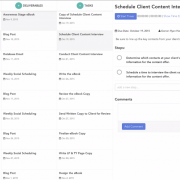Build a Content Creation Culture!
Good content is the lifeblood of businesses.
It’s really the cornerstone of so many disciplines: Search engine optimization, user experience and design, customer support, marketing — more and more businesses and consumers both rely on the creation of useful, credible, and engaging content.
When companies seek to create internal knowledge bases, they’re building content. They’re capturing the knowledge that resides in their employees’ minds and transferring it to a place where it can be used by others. When businesses review their external or internal site architecture, they’re looking to make their content more findable. When businesses create a blog, they’re looking to create more content that visitors to the site will find useful. I like this quote from Peter Morville talking about user experience and the importance of content:
Is it more important for your web site to be desirable or accessible? How about usable or credible? The truth is, it depends on your unique balance of context, content and users, and the required tradeoffs are better made explicitly than unconsciously. – Peter Morville
If content is so vital to so many areas of business, why is it such a pain to create?
Writing content is either undervalued (“I don’t have time to write a blog or a whitepaper”), or people underestimate their own abilities (“I’m not a very good writer”).
Overcoming these obstacles means making content creation part of your company’s culture. It’s analogous to sharing. Everyone wants employees to share knowledge, but the best way to share it is by documenting it.
A company culture built around creating content is going to blow away these complaints (excuses?). If someone isn’t a good writer, they will get better with time. A culture of content creation will quickly highlight that it’s not about writing the best blog or putting on the perfect presentation. Quality writing is important, but the biggest value to businesses and prospective customers is informative content.
The information that you have in your head is valuable. What resides there is a combination of know-how, experience, and stories of problems faced and overcome that should be shared with others. As an example, many companies, particularly technology companies, have brown bag lunches where employees talk about something they’ve learned or something they want to share with their colleagues. It’s informal and voluntary, but the idea is to get people sharing ideas and talking about them.
The same is true for Lessons Learned documents. Lessons Learned documents are a project management tool to document the experiences, good or bad, during a project. The idea is to get the knowledge that someone has into the organization in a documented form so that it can be learned from, and shared with others. It’s not graded on some scale of how well written it is — the knowledge is the important part!
Content creation takes time, though not nearly as much as people think. More importantly, it’s as critical as anything else you do. You need to prioritize content creation alongside making sure your accounts receivables are collected. It’s that important. Consider these two scenarios:
-
If an employee already knows the solution to a problem, documented it, and posted it to a company wiki, the next time that problem is encountered, they have reduced the time and effort to solve it. The knowledge isn’t lost.
- Similarly, if a visitor to your blog finds helpful information that also solves their problem, they are much more likely to keep coming back to your site, and more likely to turn into a potential customer.
In both cases, content creation results in either reducing costs or increasing revenue.
The best part about content is its reusability. Going back to the brown bag lunch talk and the lessons learned document, there is absolutely no reason these can’t be reused for blogs, white papers, eBooks or videos.
Taking your brown bag lunch presentation or your lessons learned document to your blog is a great way to share the information you’ve learned with your customers. A little extra effort can turn the employee’s brown bag talk into a slidedeck presentation, a video, and a blog post – Three unique pieces of sharable content that attract leads from one brown bag lunch.
The initial gut reaction from many is “Isn’t this proprietary? Do I REALLY want to share that knowledge?”
The more you give, the more you get, in this case. Your visitors are looking for informative, valuable content that shows you know your stuff. If they get a whiff of BS, they are going to go elsewhere. Being open, and providing useful knowledge makes you a trusted authority, and provides a competitive advantage that’s more durable than hoarding what you know.
By turning a lessons learned document into a blog post, you are actually sharing some of the most engaging and unique content possible. While your competition is still posting marketing about how wonderful and perfect their product or service is, you’re providing how-tos, problems to watch out for, and best practices. In the end, you will be rewarded far more for this openness than you would for being closed off.
Building a company that makes writing a priority isn’t easy. There’s a lot of headwinds and resistance (and a huge shoutout to some of my great clients who have done just that). However, the benefit extends beyond inbound marketing and increased leads and revenue (though that should be enough!) The benefits can be felt across the company and in all departments.
Thanks to Jeffrey Beall, who gave me his lunch bag courtesy of Flickr










